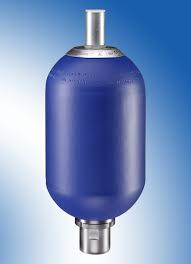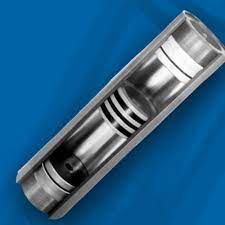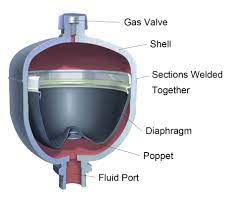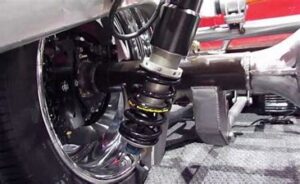Hydraulic accumulators are simple devices that are used to store energy. Just as rechargeable batteries work in electrical systems, hydraulic accumulators store and discharge energy in the form of fluid that is pressurized and are usually used to improve the efficiency of the hydraulic system. An accumulator is a pressure vessel that is used to hold a hydraulic fluid and a compressible gas that is nitrogen in most cases.
The housing, also known as shell is made up of materials such as steel, stainless steel, aluminum, titanium, and fiber-reinforced composites. Inside this housing or shell, a moveable or flexible barrier, typically a piston or bladder made up of rubber, split up the oil from the gas. An accumulator makes a hydraulic system able to cope with a lot of demand using a less powerful pump, to give a response more quickly to a temporary demand, and to smoothen out the pulsations.
Table of Contents
Working Of Hydraulic Accumulators:
In these hydraulic accumulators, hydraulic fluids get compressed only slightly under some pressure. On contrary to this, gases can be compressed into a lot lesser volumes under very high pressures. Potential energy gets stored in the compressed gas and gets released when required to force the oil from the accumulator into the circuit.
At first, the gas volume is recharged, typically around 80 to 90% of the minimum working pressure of the system. This helps the gas volume to expand and fill most of the accumulator and only a small quantity of oil remains inside the device. During its work, the hydraulic pump raises the pressure of the system and forces the fluid to enter the accumulator. Valves are used to control the flow of oil in and out. The piston or bladder moves and compresses the volume of the gas because fluid pressure exceeds the older pressure. This is the source of the stored energy that is to be used.
Motion stops when the pressure of the system and the gas get balanced. Whenever a downstream work like the movement of the actuator creates system demand, the pressure of the hydraulic system gets lowered and the accumulator releases the stored fluid, which is pressurized to the circuit. When the motion stops, the cycle which involves the charging starts again.
Types Of Hydraulic Accumulators:
There are three common types of hydraulic accumulators: bladder hydraulic accumulators, piston hydraulic accumulators, and diaphragm hydraulic accumulators.
- Bladder accumulators consist of large ports that permit the discharge of the fluid very rapidly and help to make sure that the device is not sensitive to dirt and other contamination. Bladder-type accumulators are typically manufactured in a way that they have a 4:1 pressure ratio (the ratio of the maximum pressure to gas-charged pressure) so that they can protect the bladder from distortion and material strain.

Bladder accumulators are viewed by experts as the best general-purpose hydraulic accumulators. These are available in a wide range of standard sizes, and good response properties make them something very good for applications where shocks are involved which is their main advantage. Another advantage is that a bladder could be easily replaced if there is some failure or damage.
- A piston accumulator is more similar to a hydraulic cylinder which does not have a rod. A normal piston accumulator contains a section consisting of fluid and another section consisting of gas and the movable piston separates two sections.

The main advantage is that piston accumulators are usually recommended for large amounts of stored volumes and are capable to have high flow rates. Pressure ratio is limited in these only by the design, but they are not recommended for applications involving shocks, which is the main disadvantage. These are usually made for rugged and heavy-duty applications. But, these are more sensitive to the contamination that could ruin the seals.
- Diaphragm accumulators work a lot similar to bladder accumulators. The only difference is that in place of a rubber bladder, this system uses an elastic diaphragm to separate the volumes of oil and gas. Diaphragm accumulators are very economical and compact devices. These have very lightweight. These offer relatively small flow and volume.

A diaphragm accumulator can handle higher compression ratios of up to 8 to 10:1 just because the rubber barrier does not get distorted to the same degree as a bladder does. They also have wider mounting flexibility, are not sensitive to any kind of contamination and quickly respond to any changes in pressure, being its advantages. This makes them suited for applications involving shocks.
Functions Of Hydraulic Accumulators:
These are used in many situations, for example,
- Safety And Emergency: An accumulator can provide flow and pressure to perform an additional job or complete the cycle of the machine in the event of an electrical power failure.
- Compensation Of Leakage: An accumulator can maintain the pressure and make up for lost fluid due to internal leakage of the components of a system including the cylinders as well as valves.
- Thermal Expansion: An accumulator can absorb any differences in pressure caused due to temperature variations in a closed hydraulic system.
- Conservation Of Energy: It can supplement the pump during high demand thereby decreasing the size of the pump and the motor needed.
- Improved times of responses: An accumulator is known to have a virtually instantaneous response time that can provide fluid very quickly to fast-acting valves.
Applications Of Hydraulic Accumulators:
Accumulators are used widely to store fluid power to do a lot of jobs, some of which are:
- Standby power supply circuits
- Surge reduction circuits
- Forestry Equipment
- Mobile and construction equipment
- Suspension in vehicles
1. What Are The 3 Types Of Accumulators?
2. What Are The Different Types Of Accumulators?
There are four principal types of accumulators: the weight-loaded piston type, diaphragm (or bladder) type, spring type, and hydro-pneumatic piston type. The weight-loaded type was the first used but is much larger and heavier for its capacity than the modern piston and bladder types.
3. What Do Hydraulic Accumulators Do?
4. How Do Hydraulic Accumulators Work?
Conclusion:
Accumulators can store energy that can be used to supplement the pump flow, improve the response of the system or serve as a backup during any kind of power failure.
These can also be used to compensate for leakage or thermal expansion, and reduce vibration, pulsations, and even shocks.



